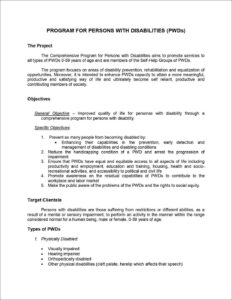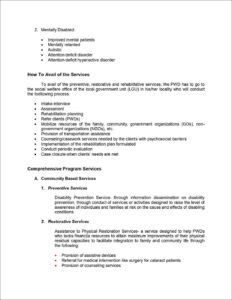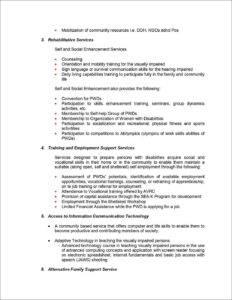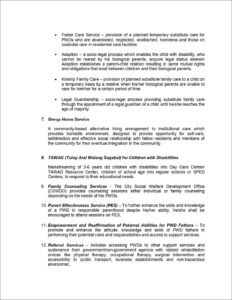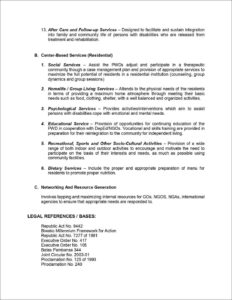The Department of Social Welfare and Development (DSWD) is the government agency responsible for social welfare and development programs and services in the Philippines. One of the DSWD’s primary mandates is to protect and promote the rights of persons with disabilities (PWDs).
The Comprehensive Program for Persons with Disabilities (PWDs) is a program that provides social protection and assistance to PWDs in order to improve their quality of life. The program includes services such as medical and financial assistance, livelihood training, and community-based rehabilitation.
Also Read: How to Claim OWWA Disability and Dismemberment Benefits
In line with this mandate, DSWD has put in place various programs and services specifically designed to cater to the needs of PWDs. These programs and services are aimed at enhancing the quality of life of PWDs, helping them become more self-reliant, and empowering them to live independently
Contents
- What are the DSWD Programs and Services for Persons with Disabilities?
- DSWD Community-Based Services for PWDs
- 1. Preventative Care Services For The Prevention Of Disablement
- 2. Counseling and Therapy
- 3. Services for Recovery and Reintegration
- 4. Services to Assist in Training and Finding a Job
- 5. Availability of a Wide Range of Digital Media and Communication Tools
- 6. Alternative Family Support Service
- 7. Assistance for Residents of Residential Care Facilities
- 8. TAWAG (Tuloy Aral Walang Sagabal) for Children With Disabilities
- 9. Help Families Through Counseling
- 10. Parent Effectiveness Service (PES)
- 11. Helping Fathers With Disabilities Feel Confident In Their Roles As Parents
- 12. Referral Services
- 13. Services for Aftercare and Continued Treatment
- PWD Benefits
- Qualifications
- How to Apply for Disability Benefits from DSWD
- PDF File about PWD Benefits for Filipinos
- Video: Program At Serbisyo Para Sa Mga Person With Disability (PWD)
- Frequently Asked Questions
- 1. What is the DSWD Comprehensive Program for Persons with Disabilities?
- 2. What are the eligibility requirements for the DSWD Comprehensive Program for Persons with Disabilities?
- 3. How can I apply for the DSWD Comprehensive Program for Persons with Disabilities?
- 4. What are the benefits of the DSWD Comprehensive Program for Persons with Disabilities?
- 5. How long does the DSWD Comprehensive Program for Persons with Disabilities last?
- 6. What is the difference between a disability and an impairment?
- 7. How does the government define a person with a disability?
- 8. What are the types of disabilities?
- 9. How many people in the Philippines have a disability?
- 10. What causes disabilities?
- Summary
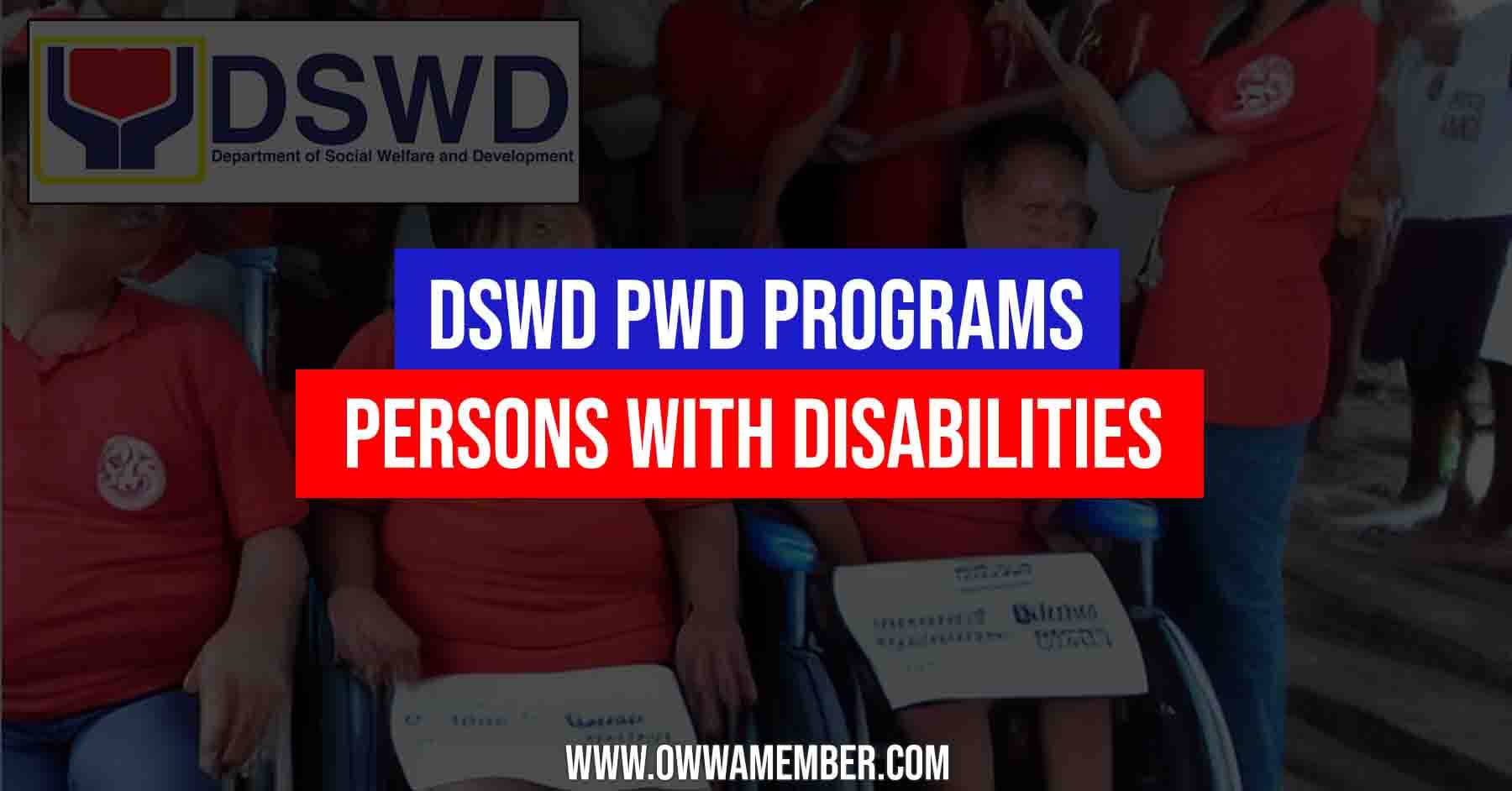
What are the DSWD Programs and Services for Persons with Disabilities?
The primary goal of the Comprehensive Program for PWD is to provide services to PWD between the ages of 0 and 59 who are members of a PWD Self-Help Group.
The primary objectives of the program are to level the playing field, help individuals who already have disabilities recover, and stop others from developing them. Its ultimate goal is to enable people with disabilities to live independent, fulfilling lives in which they make meaningful contributions to their communities.
DSWD Community-Based Services for PWDs
1. Preventative Care Services For The Prevention Of Disablement
by educating the public about the importance of preventing disabilities, and by providing services and holding events that do just that, we can help those most at risk learn more about the factors that put them and their loved ones at risk.
2. Counseling and Therapy
Helping people with disabilities (PWDs) who are low-income recover their physical residual capacities as much as possible so that they can participate more fully in family and community life is the goal of a program called Assistance to Physical Restoration Services.
- Giving out aids to the handicapped
- Patients with cataracts are referred for medical treatment, such as surgery.
- Provid[ing] Counseling Services
- Gathering of local assets like the Department of Health, non-profits, and Pos
3. Services for Recovery and Reintegration
Personal and Interpersonal Development Programs
- Counseling
- Teaching the sight impaired how to get around
- Hearing-impaired people need to learn sign language or other forms of auxiliary communication to get by in the world.
- Skills necessary for daily life preparation for active participation in domestic and social contexts
Further benefits of self-and social improvement include:
- Disabled People’s Convention
- Involvement in programs designed to improve one’s abilities (such as seminars, activities designed to foster teamwork, etc.).
- Participation in a Disabled Persons’ Self-Help Group
- Disability Women’s Organization (DWO) Membership
- Involvement in various forms of physical and social activity, such as games and sports
- Ability Games (Abilympics) Competition Participation
4. Services to Assist in Training and Finding a Job
Preparatory services for people with disabilities to learn the social and vocational skills necessary to keep gainful (open, self, and sheltered) self-employment in their homes or communities.
- Training in the workplace or referral for employment based on an evaluation of the person’s strengths and interests, as well as any vocational training, counseling, or retraining that may be necessary.
- Participation in AVRC’s Vocational Education Program
- Financing aid through the State Energy Assistance and Knowledge Transfer Program (SEA-K) for construction
- Gainful employment via the Protected Employment Program
- Fewer resources are available to help disabled people financially as they look for work.
5. Availability of a Wide Range of Digital Media and Communication Tools
- A public program that teaches people how to use computers and how to function in society so that they can make positive contributions.
- Adaptive Technology for Educating the Visually Impaired is a graduate-level course that teaches students how to utilize a screen reader to access the internet, create an electronic spreadsheet, and find entry-level employment using just their voices.
6. Alternative Family Support Service
- Planned temporary substitute care for people with disabilities who have been abandoned, neglected, unattached, homeless, or who are receiving custodial care in residential care facilities.
- A child whose biological parents are unable to provide for him or she legally and socially gains the same rights and duties as if reared by his or her parents through the process of adoption. Adoption is so effective because it establishes a permanent bond between a parent and a child.
- When a kid’s biological parents are temporarily unable to care for them, kinship family care allows for the child to stay with a relative instead.
- The legal guardianship procedure is a social and legal mechanism by which a kid is provided for instead of his or her biological parents until the youngster reaches the age of majority.
7. Assistance for Residents of Residential Care Facilities
Community-based settings outside of institutions aim to help people develop life skills such as self-care, self-direction, and positive interpersonal interactions with other residents and community members in preparation for full community inclusion.
8. TAWAG (Tuloy Aral Walang Sagabal) for Children With Disabilities
Daycare centers/TAWAG Resource Centers for children ages 3-6 are ideal settings in which to meet the educational needs of children with special needs who are not yet old enough to attend regular schools.
9. Help Families Through Counseling
Depending on the situation, the CSWDO offers PWDs either individual or family counseling.
10. Parent Effectiveness Service (PES)
A person with a disability should be encouraged to participate in PES sessions to improve his or her knowledge and abilities related to responsible parenting.
11. Helping Fathers With Disabilities Feel Confident In Their Roles As Parents
The goal of this project is to increase the number of fathers who are people with disabilities and to improve the level of education and training these fathers to have to fulfill their potential roles and responsibilities and take advantage of available support systems.
12. Referral Services
Access to public transportation, commercial establishments, and a safe environment, as well as related rehabilitation services like occupational therapy, physical therapy, surgical intervention, and other forms of support and sustenance provided by the government and non-government agencies, are all part of this umbrella term.
13. Services for Aftercare and Continued Treatment
This program is meant to help people with disabilities who have recently completed rehabilitation or therapy transition back into their homes and communities.
PWD Benefits
A comprehensive program for people with disabilities that aims to improve their quality of life. Reduce the incidence of disability by:
- Enhancing their capacity to avoid, detect, and manage impairments and debilitating conditions
- Alleviate a person with disabilities (PWD) impairments and prevent further decline
- Make sure people with disabilities (PWDs) enjoy full participation in all areas of society, including political and civic life, economic participation, education and training, housing, health, and leisure activities.
- Raise consciousness about the limited but valuable contributions that people with disabilities can nonetheless make in the workforce.
- Raise awareness of the challenges faced by people with disabilities and their entitlement to social equality.
Qualifications
Disabled people are those who, for whatever reason (physical, mental, or sensory), cannot or do not do an activity in the way that is typical for a human being of either sex between the ages of 0 and 59.
Types of Person with Disabilities
1. Physically Handicapped:
- Poor eyesight
- Disabled in hearing
- I’m impaired in the joints
- Disabilities of a different sort (cleft palate, harelip which affects their speech)
2. Mentally Disabled
- Patients with mental illness have made progress
- Deficient in intellectual capacity
- Autistic
- A.D.H.D. = Attention Deficit Hyperactivity Disorder
How to Apply for Disability Benefits from DSWD
The social welfare office of the PWD’s local LGU will carry out the following steps to ensure the PWD has access to the preventative, restorative, and rehabilitative services available in the area:
- Preliminary Questioning
- Assessment
- Organizational Strategies for Rehabilitation
- Provide Clients for Referral (PWDs)
- Make use of the available family, community, government, NGO, and other resources.
- Assistance with transportation was provided.
- Clients with psychosocial difficulties require counseling and casework assistance.
- Rehabilitation strategy implementation
- Make regular assessments
- The finalization of a case occurs when all client requirements have been met.
PDF File about PWD Benefits for Filipinos
Here’s an file which discusses in-depth about what PWDs are and what are the existing policies and regulations to take care of disabled people in the Philippines:
Video: Program At Serbisyo Para Sa Mga Person With Disability (PWD)
Here’s a video about services and programs offered to PWD.
The video discusses all the programs and services DSWD offers to all Persons With Disabilities.
Frequently Asked Questions
1. What is the DSWD Comprehensive Program for Persons with Disabilities?
The DSWD Comprehensive Program for Persons with Disabilities is a social protection program that provides assistance to eligible individuals with disabilities. The program aims to help beneficiaries meet their basic needs, as well as access education, employment, and other opportunities.
2. What are the eligibility requirements for the DSWD Comprehensive Program for Persons with Disabilities?
To be eligible for the DSWD Comprehensive Program for Persons with Disabilities, an individual must:
-Be a Filipino citizen
-Have a disability that has been medically diagnosed by a physician
-Be living below the poverty line, as determined by the National Economic and Development Authority (NEDA)
3. How can I apply for the DSWD Comprehensive Program for Persons with Disabilities?
Individuals who meet the eligibility requirements for the program may submit an application to the nearest DSWD office. The application must be accompanied by a medical certificate confirming the applicant’s disability, as well as proof of income.
4. What are the benefits of the DSWD Comprehensive Program for Persons with Disabilities?
- discounts on purchases and services
- assistance with educational expenses
- special discounts on necessities
- transportation subsidies
- etc.
5. How long does the DSWD Comprehensive Program for Persons with Disabilities last?
The program is designed to provide long-term assistance to beneficiaries. However, individuals may receive benefits for a maximum of five years. After this period, they will be required to re-apply for the program.
6. What is the difference between a disability and an impairment?
An impairment is a condition that limits a person’s ability to perform an activity in the way that is typical for a human being. A disability is a label that society gives to someone who has an impairment.
7. How does the government define a person with a disability?
The government defines a person with a disability as someone who, for whatever reason (physical, mental, or sensory), cannot or does not do an activity in the way that is typical for a human being of either sex between the ages of 0 and 59.
8. What are the types of disabilities?
There are three main types of disabilities: physical, mental, and sensory.
9. How many people in the Philippines have a disability?
According to the National Statistics Office, there are 1.44 million people in the Philippines with a disability. This is about 1.57% of the population.
10. What causes disabilities?
There are many causes of disabilities, including genetic conditions, birth defects, accidents, and illnesses.
Summary
In the Philippines, the Department of Social Welfare and Development (DSWD) is the agency tasked to lead in the formulation, coordination, and monitoring of programs and services for persons with disabilities (PWDs).
The government offers many programs and services to Persons With Disabilities to help them live more normal lives. These services range from transportation assistance to counseling and casework assistance.
If you or someone you know has a disability, be sure to take advantage of the resources that are available to you.
